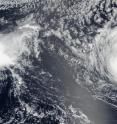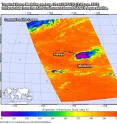NASA sees a weaker Tropical Storm Madeline passing south of Hawaii's Big Island
Related images
(click to enlarge)
Once a major hurricane, Madeline was a tropical storm that appeared shapeless on a visible satellite image as it was passing south of the big island of Hawaii. An infrared image showed the storm stretching from southwest to northeast. The Atmospheric Infrared Sounder or AIRS instrument aboard NASA's Aqua satellite provided an infrared look at Tropical Storm Madeline on Aug. 31 at 2341 UTC (7:41 p.m. EDT). Infrared data shows temperatures and the stronger storms with coldest cloud top temperatures were confined to the northeast quadrant of the circulation. Those strong storms were becoming more distanced from the storm's circulation center.
On Aug. 31 at 6:50 p.m. EDT (22:50 UTC) the Visible Infrared Imaging Radiometer Suite (VIIRS) instrument aboard NASA-NOAA's Suomi NPP satellite provided a visible image of Tropical Storm Madeline approaching Hawaii. In the image, Madeline appeared to be almost shapeless.
Madeline weakened to a tropical storm on Aug. 31 by 8 p.m. EDT (2 p.m. HST). At 11 p.m. EDT (5 p.m. HST) on Aug. 31 Madeline was passing just south of the Big Island of Hawaii as a tropical storm with maximum sustained winds near 65 mph (100 kph).
At 11 a.m. EDT (5 a.m. HST/1500 UTC), forecaster Birchard of NOAA's Central Pacific Hurricane Center (CPHC) noted "After a several hour period where Madeline had a rather ragged satellite presentation, a burst of deep convection developed near the center around midnight, and has since persisted with an abundance of lightning."
At that time the center of Tropical Storm Madeline was located near latitude 16.7 degrees north latitude and 157.0 degrees west longitude.
Madeline is moving toward the west near 14 mph (22 kph) and this general motion is expected to continue for the next couple of days. The estimated minimum central pressure is 1003 millibars. Maximum sustained winds are near 50 mph (85 kph) with higher gusts. Some weakening is forecast during the next 48 hours, and Madeline is forecast to become a Tropical Depression by Friday, Sept. 1.
There are no coastal watches or warnings in effect in association with Madeline anymore in Hawaii. However, interests on Johnston Island should monitor the progress of Madeline.
For updated forecasts on Madeline, visit the CPHC website: http://www.prh.noaa.gov/cphc
Source: NASA/Goddard Space Flight Center
Articles on the same topic
- NASA sees Hurricane Lester approaching Hawaiian IslandsFri, 2 Sep 2016, 17:06:25 UTC
- NASA sees Lester move into central Pacific Ocean basinThu, 1 Sep 2016, 16:26:27 UTC
- Satellites show Hurricane Madeline weakening upon approach to HawaiiWed, 31 Aug 2016, 20:04:10 UTC
- NASA's GPM examines Category Four Hurricane LesterWed, 31 Aug 2016, 16:06:48 UTC
- NASA satellite catches major Hurricane Madeline as Hawaii bracesTue, 30 Aug 2016, 17:15:37 UTC
- NASA looks at Eastern Pacific's Category 3 Hurricane LesterTue, 30 Aug 2016, 17:15:25 UTC
Other sources
- Lester downgraded to tropical depression in Pacificfrom UPISun, 4 Sep 2016, 21:21:15 UTC
- NASA sees Hurricane Lester approaching Hawaiian Islandsfrom PhysorgFri, 2 Sep 2016, 18:31:24 UTC
- Hawaiian islands prepare for Hurricane Lesterfrom UPIFri, 2 Sep 2016, 10:31:25 UTC
- NASA sees Lester move into central Pacific Ocean basinfrom PhysorgThu, 1 Sep 2016, 17:32:01 UTC
- NASA sees a weaker Tropical Storm Madeline passing south of Hawaii's Big Islandfrom PhysorgThu, 1 Sep 2016, 17:31:54 UTC
- Hawaii avoids direct hit from Tropical Storm Madeline; Hurricane Lester loomsfrom UPIThu, 1 Sep 2016, 11:31:28 UTC
- Hawaii declares emergency as it prepares for first Hurricane hit since 1949from UPIThu, 1 Sep 2016, 1:01:18 UTC
- Satellites show Hurricane Madeline weakening upon approach to Hawaiifrom PhysorgWed, 31 Aug 2016, 22:31:23 UTC
- Cameras On The ISS Capture Gorgeous Time-Lapse Footage Of Three Hurricanesfrom PopSciWed, 31 Aug 2016, 19:31:13 UTC
- 3 for 1: Space Station Eyes Hurricanes Lester, Madeline and Gastonfrom Space.comWed, 31 Aug 2016, 18:41:22 UTC
- 3 for 1: Space Station Eyes Hurricanes Lester, Madeline and Gastonfrom Live ScienceWed, 31 Aug 2016, 18:41:21 UTC
- NASA's GPM examines Category Four Hurricane Lesterfrom PhysorgWed, 31 Aug 2016, 16:01:40 UTC
- Madeline weakens to Category 1 but still headed for Big Islandfrom UPIWed, 31 Aug 2016, 13:31:24 UTC
- Hurricane Madeline weakens to category 3, but still packing punch near Hawaiifrom UPIWed, 31 Aug 2016, 1:01:15 UTC
- Three Hurricanes Seen From Space Station On Same Day | Time-Lapse Videofrom Space.comTue, 30 Aug 2016, 21:11:20 UTC
- Three Hurricanes Seen From Space Station On Same Day | Time-Lapse Videofrom Live ScienceTue, 30 Aug 2016, 20:41:18 UTC
- NASA looks at Eastern Pacific's Category 3 Hurricane Lesterfrom PhysorgTue, 30 Aug 2016, 17:11:45 UTC
- NASA satellite catches major Hurricane Madeline as Hawaii bracesfrom PhysorgTue, 30 Aug 2016, 17:11:44 UTC
- Madeline strengthens into Category 4 hurricane, heads toward Hawaiifrom UPITue, 30 Aug 2016, 16:41:26 UTC
- Madeline strengthens into category 4 hurricane; heading toward Hawaiifrom UPITue, 30 Aug 2016, 15:41:20 UTC
- NASA spots Central Pacific's Madeline strengthening into a hurricanefrom PhysorgMon, 29 Aug 2016, 19:01:30 UTC

